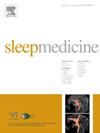不宁腿综合征成人运动差异反应的特点
IF 3.8
2区 医学
Q1 CLINICAL NEUROLOGY
引用次数: 0
摘要
目的/背景不眠之腿综合征(RLS)是一种普遍存在的感觉运动睡眠障碍,其特征是无法抗拒的运动冲动,这种冲动可以通过运动暂时缓解。尽管有证据表明运动对RLS有好处,但对运动的反应存在个体差异,因此一些人的症状得到改善,而另一些人则报告症状加剧。目前的研究调查了可能解释在RLS中对运动的感知反应差异的因素。患者/方法参与者(N = 527)完成了一项全国范围的调查,其中包括评估RLS、身体活动、久坐水平和RLS对运动反应的经历。逻辑回归分析检验了个体特征(如年龄、性别)与运动对改善和恶化的感知之间的关联。探索性分析检查了与感知到的积极反应(即,运动只改善RLS)或消极反应(即,运动只恶化RLS)相关的特征。结果随机logistic回归发现,较低的RLS严重程度(OR = 0.83, p = 0.044),较高的可能导致继发性RLS的疾病患病率(OR = 1.76, p = 0.005),较低的周期性肢体运动患病率(OR = 0.52, p = 0.001),较高的体育活动水平(OR = 1.47, p <;0.001)是运动改善RLS症状的显著、独立预测因子。个体特征有序逻辑回归发现女性与运动加重症状显著相关(OR = 0.62, p = 0.008)。探索性逻辑回归发现,BMI指数较高(OR = 0.69, p = 0.019)和RLS严重程度较高(OR = 0.70, p = 0.026)的人对运动有积极反应的几率较低。结论:本研究提出了可能解释个体对运动反应差异的因素。总的来说,我们的研究结果表明,轻度的RLS病例(严重程度较低,没有PLMs),继发性RLS患者和BMI较低的人可能认为运动更有利于缓解症状。这些应该在以运动为基础的管理中加以考虑,目的是控制症状,因为大量的研究支持运动对成人RLS患者的益处。本文章由计算机程序翻译,如有差异,请以英文原文为准。
Characteristics of the differential response to exercise in adults with restless legs syndrome
Objective/Background
Restless legs syndrome (RLS) is a prevalent, sensorimotor sleep disorder characterized by the irresistible urge to move that is temporarily relieved by movement. Despite evidence for the benefits of exercise in RLS, inter-individual variation in the response to exercise exists, whereby some people experience symptom improvement while others report exacerbations. The present study examined factors that may account for differences in perceived responses to exercise in RLS.
Patients/methods
Participants (N = 527) completed a nationwide survey with items assessing RLS, physical activity, sedentary levels, and experiences with RLS responsiveness to exercise. Logistic regression analyses examined associations between individual characteristics (e.g., age, sex) and perceptions of improvement and exacerbation with exercise. Exploratory analyses examined characteristics associated with perceived positive responsiveness (i.e., exercise only improves RLS) or negative responsiveness (i.e., exercise only worsens RLS).
Results
Ordinal logistic regression identified lower RLS severity (OR = 0.83, p = 0.044), higher prevalence of a condition that could cause secondary RLS (OR = 1.76, p = 0.005), lower prevalence of periodic limb movements (OR = 0.52, p = 0.001), and higher physical activity levels (OR = 1.47, p < 0.001) as significant, independent predictors of exercise improving RLS symptoms. Individual feature ordinal logistic regression identified female sex as significantly associated with exercise exacerbating symptoms (OR = 0.62, p = 0.008). Exploratory logistic regression identified people with higher BMI (OR = 0.69, p = 0.019) and higher RLS severity (OR = 0.70, p = 0.026) had lower odds of being positive responders to exercise.
Conclusions
The present study presents factors that might account for individual differences in the response to exercise. Overall, our results suggest that milder cases of RLS (lower severity, absence of PLMs), people with secondary forms of RLS, and those with a lower BMI may perceive exercise as more beneficial for symptoms. These should be considered in exercise-based management aimed at managing symptoms as the collective body of research supports the benefits of exercise in adults with RLS.
求助全文
通过发布文献求助,成功后即可免费获取论文全文。
去求助
来源期刊

Sleep medicine
医学-临床神经学
CiteScore
8.40
自引率
6.20%
发文量
1060
审稿时长
49 days
期刊介绍:
Sleep Medicine aims to be a journal no one involved in clinical sleep medicine can do without.
A journal primarily focussing on the human aspects of sleep, integrating the various disciplines that are involved in sleep medicine: neurology, clinical neurophysiology, internal medicine (particularly pulmonology and cardiology), psychology, psychiatry, sleep technology, pediatrics, neurosurgery, otorhinolaryngology, and dentistry.
The journal publishes the following types of articles: Reviews (also intended as a way to bridge the gap between basic sleep research and clinical relevance); Original Research Articles; Full-length articles; Brief communications; Controversies; Case reports; Letters to the Editor; Journal search and commentaries; Book reviews; Meeting announcements; Listing of relevant organisations plus web sites.
 求助内容:
求助内容: 应助结果提醒方式:
应助结果提醒方式:


